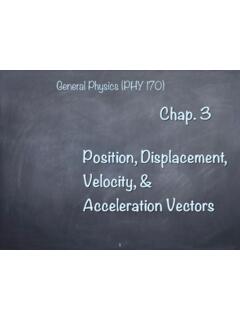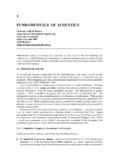Transcription of Experimental Determination of the Speed of Light by the ...
1 Experimental Determination of the Speed of Light by the Foucault Method R. Price and J. Zizka University of Arizona The Speed of Light was measured using the Foucault method of reflecting a beam of Light from a rotating mirror to a fixed mirror and back creating two separate reflected beams with an angular displacement that is related to the time that was required for the Light beam to travel a given distance to the fixed mirror. By taking measurements relating the displacement of the two Light beams and the angular Speed of the rotating mirror, the Speed of Light was found to be ( )x108 m/s, which is within of the defined value for the Speed of Light .
2 1 Introduction The goal of the experiment was to experimentally measure the Speed of Light , c, in a vacuum by using the Foucault method for measuring the Speed of Light . Although there are many Experimental methods available to measure the Speed of Light , the underlying principle behind all methods on the simple kinematic relationship between constant velocity, distance and time given below: c=Dt (1) In all forms of the experiment, the objective is to measure the time required for the Light to travel a given distance.
3 The large magnitude of the Speed of Light prevents any direct measurements of the time a Light beam going across a given distance similar to kinematic experiments. Galileo himself attempted such an experiment by having two people hold lights across a distance. One of the experiments would put out their Light and when the second observer saw the Light cease, they would put out theirs. The first observer would time how long it took for the second Light to go out, giving an estimate on the Speed of Light . However, it was found that the time lapse between the two events was near instantaneous suggesting that such a method was not precise enough, and a more interesting result at the time, that the Speed of Light was much larger in magnitude than thought1.
4 To correct for these problems, Foucault devised a method which was able to avoid such issues by indirectly measuring the time the Light traveled. Foucault s method used a Light source and rotating mirror together to derive the Speed of light2. The Foucault method uses the Light source to produce a focused beam on the rotating mirror. The Light from the rotating mirror is then reflected at an angle to a fixed mirror which is aligned to face perpendicular to the reflected Light beam. Therefore the Light is reflected directly back to the rotating mirror where it was first reflected.
5 During the time the Light had traveled the distance between the two mirrors, the rotating mirror had changed its orientation to the beam of Light , thus the 1,2 Hecht, Eugene. Optics, 4th Edition. San Francisco: Addison Wesley, 2002. 16 October 2007 Page 2 of 9 returning beam of Light will be reflected off at a separate angle. The difference in the angle between the Light source to the rotating mirror and the rotating mirror the second reflected beam is related to the time that was required by the Light to travel the distance between the fixed and rotating mirrors.
6 Using the relations of the Experimental setup, Equation 1 was used to determine the Speed of Light . Setup For the experiment the methods were updated to use modern equipment to provide more accurate and precise results. A diagram of the Experimental setup is shown below in Figure 1: Figure 1 - Diagram of Experimental Setup The experiment used a laser to provide as the Light beam because it creates a focused beam of Light to travel between all components. The rotating mirror used was a double sided plane mirror attached to a motor apparatus that allowed a variable control of the motor rotation Speed .
7 The rate of rotation was measured using a Light sensor in conjunction with a frequency counter. As the mirror rotated with the laser positioned on it, there was an angle of the mirror that reflected the laser Light beam toward the Light sensor. When the laser beam was directed at the Light sensor, it created a voltage which could be then measured by a connected frequency counter. A lens with a 5 meter focal length was placed between the rotating and fixed mirrors because the laser beam had an angular divergent property associated with the beam.
8 Over large distances, the laser 16 October 2007 Page 3 of 9 beam became too dispersed to be targeted precisely onto the two mirrors. The lens focused the laser beam directly to a point source on both mirrors making the beams more precisely optically aligned. A beam splitter was used in order to redirect the returning Light beam onto a frosted glass plate. The frosted glass plate allowed a simplification in viewing because it disperses the incoming laser beams in all direction so that a head-on viewing angle with the microscope is not required.
9 The difference between these two points was measured by using the measuring microscope placed in front of the frosted glass screen and recording the value of displacement of the two beams. Derivation From simple kinematics, the Speed of Light is related to the time t it takes a beam of Light to travel a distance D from Equation 1. In the experiment, the distance and time measured were for a beam of Light to travel between the rotating and fixed mirrors and back in Figure 1. Therefore by the setup the time to travel the distance was: t=2Dc (2) However, during the time period t, the rotating mirror is held at a fixed angular velocity of.
10 Because the angular velocity is constant, then = (3) The angular dependence is also related to the return of the Light beam to the beam splitter and the displacement x of the Light beam on the frosted glass plate. The angle between the two laser beams striking the beam splitter is determined from the law of reflection: i= r (4) For a beam of Light striking a stationary mirror, the total angle between the reflected and incident Light beams is given as.









